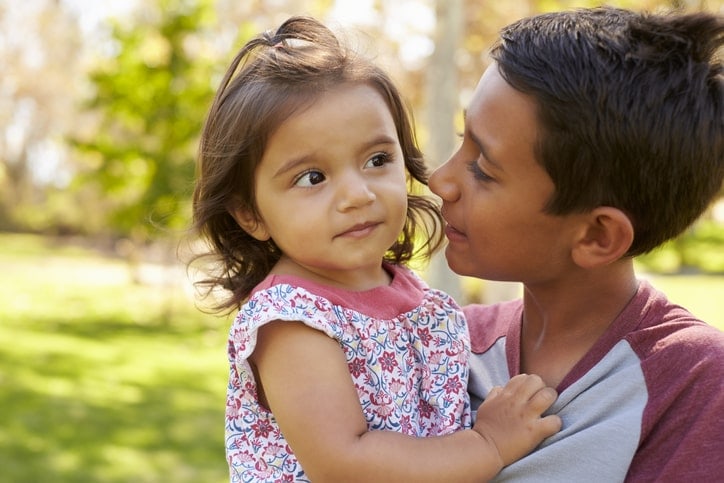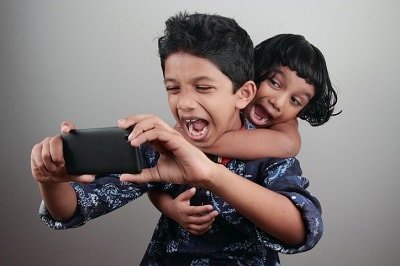Can you teach empathy? Yes. But teaching empathy depends on more than being a good role model. It depends on more than assigning kids a few educational activities. We need to understand the psychology of empathy, and the basic skills that children need to share emotions, read minds, and offer help.

Teaching empathy? That might sound strange if you think of empathy as an innate, fixed trait — a talent that some people are born with, and others lack. But empathy isn’t an all-or-nothing proposition. It isn’t something that unfolds automatically, in every situation. It isn’t even a single ability or skill.
As researchers (Decety and Cowell 2014) have argued, the word “empathy” has become a catch-all term for at least three distinct processes:
- feeling another individual’s emotions (e.g., if you feel scared, it makes me feel scared);
- reasoning about another person’s perspective (e.g., you “put yourself in my shoes,” and try to imagine what I am thinking or feeling); and
- wanting to help — feeling sympathy and concern for someone who is vulnerable or distressed.
And each of these processes is shaped by learning.
Take the ability to feel another individual’s emotions. This ability — called “affective empathy” — seems very basic and innate. As I explain elsewhere, it appears to exist in newborn babies, and in a variety of non-human animals.
But that doesn’t mean that the development of affective empathy isn’t influenced by learning.
For example, your baby might feel distressed because he hears another infant crying. But can he share your every emotion?
No. He doesn’t yet know how to decipher all your facial expressions. He doesn’t yet understand the range of feelings that you can experience, or the situations that provoke them.
The development of affective empathy depends, in part, on a child’s experiences — how people communicate with her; what kinds of social relationships she has; whether we help her cope with shared emotions that feel unpleasant or overwhelming.
And the same can be said for the other empathic processes.
To take another person’s perspective, you need to know something about his or her world.
To show sympathy, you need to recognize what another person needs. And you may also need to feel a sense of justification — that the individual is deserving. Cultural forces — including authority figures and the popular media — shape a child’s attitudes about what sorts of individuals deserve their empathy.
So empathy isn’t something you either have or lack, and it isn’t something that develops automatically, without input from the environment.
Personal experience matters. Culture matters. Parenting matters.
Here are some tips for steering kids in the right direction.
Teaching empathy tip #1: Provide children with the support they need to develop strong self-regulation skills.

Feeling someone else’s pain is unpleasant, so it shouldn’t surprise us if a child’s first impulse is to shrink away. It’s a natural, self-protective reaction.
But to become sympathetic helpers — and not mere bystanders — kids need to learn to control this impulse. And we can help in multiple ways.
First, we can help by practicing “positive parenting” — a sensitive, responsive approach to child-rearing that makes kids feel secure.
Decades of research attest to the benefits of sensitive, responsive parenting.
It makes kids feel they can count on us for emotional and physical support, which leads to stronger, more secure social relationships. And what happens when kids feel secure? They are more likely to take emotional risks — to get involved when they see somebody who needs sympathy and help (Waters et al 1979; Kestenbaum et al 1989; Barnett 1987). For examples of how to practice positive parenting, see this Parenting Science guide.
Second, we can help by teaching kids how to cope constructively with their own, negative emotions.
Children who are better at regulating their negative emotions tend to show greater empathic concern for others (Song et al 2017). So it makes sense to provide kids with “emotion coaching.”
This means acknowledging (rather than dismissing) negative feelings, and engaging kids in conversations about the causes and effects of emotions.
It also means helping kids find constructive ways to handle their bad moods.
Studies show that “emotion coaching” can help kids of all ages. But younger children — who struggle with negative emotions — may benefit the most (Johnson et al 2017).
So if you have a toddler, it isn’t too early to start thinking about your role as an emotion coach. In one experiment, parents who were encouraged to increase their coaching efforts produced immediate, positive effects. Preschoolers showed improvements in their ability to handle frustration (Loop and Roskam 2016).
Where to start? See this Parenting Science article about becoming an effective emotion coach.
Teaching empathy tip #2: Understand how feelings of guilt and shame can affect a child’s empathic responses.

Imagine two siblings: a toddler and his older brother.
The toddler is crying. He fell down and hurt his knee. He’s bleeding and seems really distressed.
The older brother — let’s call him Sam — is watching. Does he show empathy? Does he try to help?
It depends on the circumstances.
Suppose the toddler was knocked off his feet by an overly-enthusiastic dog.
In this case, Sam will very likely feel empathy, and show it. He’ll behave sympathetically toward his younger sibling.
But what if Sam was responsible for the toddler’s fall?
It might have been an accident. Or maybe the older brother was angry, and momentarily lost his temper. Either way, he played a role in his young brother’s injury.
Now things are more complicated. Sam’s reactions include feelings about himself, about what he’s done. And these self-conscious feelings can get in the way of an empathic response.
In particular, Sam is less likely to show empathy if he feels like he’s the “bad guy” — or if he feels like other people regard him as the “bad guy.”
When we feel ashamed — or feel targeted by shaming tactics — we don’t usually respond in a constructive or prosocial way (Tangney 1994).
If we accept the shame, we tend to feel helpless. We withdraw or sulk. If we reject the shame directed at us, we tend to feel resentful and angry. We double down. Maybe even lash out.
Decades of research bares this out. Shame doesn’t make us into better people. It doesn’t make us reach out to victims. It makes respond in ways that seem uncaring, or even aggressive (Miceli and Castelfranchi 2018).
By contrast, Sam is more likely to show empathy — and try to make amends — if he feels a sense of guilt.
Guilt is different than shame. When we feel guilty, we reflect on our bad choices, and — most especially — we focus on the harm our mistakes have caused to others.
As a result, feelings of guilt inspire us to respond constructively. We don’t feel helpless. We don’t feel resentful and angry. We feel sad for the suffering of others, and we want to make things better.
So if we want our kids to respond to these situations with empathy, we need to avoid feelings of shame. If Sam seems unrepentant or unfeeling, we shouldn’t denounce him as bad. We shouldn’t confront him in a way that makes him feel threatened or humiliated.
Instead, we should call his attention to the consequences of his behavior, talk with him about how his brother is feeling, and help him find ways to make amends.
Teaching empathy tip #3: Seize everyday opportunities to switch on your child’s empathy mode.

From infancy, kids display a capacity for empathy. But — like us — they don’t always use it. So how do you encourage a child to practice empathy?
Research suggests we need only ask. A simple question — asking kids to reflect on what other people are feeling — can make a difference.
For example, in an experiment on more than 400 Dutch school children (ranging in age from 8-13 years), Jellie Sierksma and her colleagues presented kids with a hypothetical situation about a classmate.
Half the students were told to imagine that the classmate was a friend. The other half were told to imagine that the classmate was not a personal friend. And the situation was this:
It’s your classmate’s turn to stay late and clean up the classroom. But she wants to go home as soon as possible because her mother is quite ill. She asks you to help her. Would you do it?
What did kids say?
It depended on friendship. Children expressed less willingness to help when the girl wasn’t depicted as a friend.
But the results changed when researchers added an extra step to the procedure — a step that made children stop and reflect.
Instead of immediately asking children if they would help, the experimenters first asked kids to think about the girl, and rate how sad or upset she was likely to be.
After rating emotions, the children showed no bias in favor of the friend. They were equally likely to say they would help the girl, whether she was a friend or not (Sierksma et al 2015). The extra reminder was enough to change children’s judgments.
Teaching empathy tip #4: Help kids discover what they have in common with other people.
Adults tend to feel greater empathy for an individual when they perceive the individual to be similar to them. They also find it easier to empathize with someone who is familiar.
And research suggests that children have similar biases (e.g., Zahn-Waxler et al 1984; Smith 1988).
As a result, one of the best ways to encourage empathy is to make children conscious of what they have in common with others.
For example, studies suggest that schools boost empathy in students when they foster multiculturalism — an inclusive, warm attitude about cultural diversity (Le et al 2009; Chang and Le 2011).
Teaching empathy tip #5: Don’t shelter your child from discussions about race. Talk openly about racial biases and injustice.
This tip is especially relevant for white parents. Why? As I explain my article, “6 mistakes that white parents make about race,” many white parents take a “color blind” approach to race: They avoid acknowledging that racial categories even exist.
Their hope is that the color blind approach will prevent kids from developing racial biases. But the data don’t support this hope.
On the contrary, children absorb racial biases from the popular culture — whether we talk about it or stay silent.
And research suggests that white kids become less biased when parents take a “race conscious” approach — acknowledging and addressing the existence of race and racism (Katz 2003; Vittrup and Holden 2011).
So an important part of teaching empathy is tackling race head-on.
As noted above, people tend to feel less empathy for individuals they perceive as different. We can counteract this effect by helping kids discover the underlying similarities they share with others.
But race affects empathy in another, more sinister way. It isn’t just that people are biased in favor of in-groups. It’s also that people are influenced by racist myths and stereotypes.
For example, researchers have documented a bizarre but alarmingly common racist myth in the United States: People are biased to assume that black individuals feel less pain that white individuals do.
This implicit assumption has been documented in black people as well as white people, and it emerges during childhood: In a study of nearly 160 kids, Rebecca Dore and her colleagues found that children showed a strong and consistent bias by the age of 10 (Dore et al 2014).
The kids — like their adult counterparts — harbor this bias regardless of their other attitudes about race, or their experiences with interracial contact. So good intentions won’t make it go away. To fight this myth, we need to talk about it — openly and explictly.
Teaching empathy tip #6: Understand the importance of perspective-taking, and nurture this form of empathy through practice exercises and group discussion.
When we talk about empathy, we often focus on affective empathy — sharing another individual’s emotions.
This emphasis is understandable. Affective empathy seems like the very bedrock of emotional intimacy. But it comes with a cost.
Sharing another person’s emotions can make us want to back away, especially when we encounter someone in pain or distress. It can also distract us. Instead of paying close attention to the needs of the other person, we become preoccupied with our own emotional plight.
So feeling affective empathy isn’t enough. To be good helpers, we also need something that psychologists call “cognitive empathy” — the ability to imagine another person’s perspective, and accurately identify what that person needs.
The process is more dispassionate and cerebral, and less stressful. It’s also leads to more accurate judgments.
In brain scan studies, individuals who score high in cognitive empathy tend to experience less stress reactivity when they witness distress in others. And they are actually better at responding in helpful ways (e.g., Ho et al 2014)!
How, then, do we foster cognitive empathy?
Emotion coaching (as mentioned above) is a good start.
Kids also benefit from games and activities that require them to think about what other people feel, think, want, and need.
For example, researchers at the University of Wisconsin-Madison have developed and tested a 12-week classroom program called the Kindness Curriculum (Flook et al 2015).
Aimed at preschoolers, it features group lessons in attention to emotions in the self and others; practical brainstorming sessions for helping others; and exercises in showing gratitude. A randomized, controlled study found the program to be effective for teaching empathy and preschool social skills (Flook et al 2015).
The researchers responsible for the Kindness Curriculum are making it available to the public for free. You can sign up for your own copy here.
Then, too, there is the power of “story talk” — discussions about the characters that kids encounter in books.
Fictional stories and real-life narratives offer excellent opportunities for sharpening a child’s perspective-taking skills.
What do the characters think, believe, want, or feel? And how do we know it? When we actively discuss these questions, kids may learn a lot about the way other people’s minds work (Kucirkova 2019; Dunn et al 2001).
For instance, in an experimental study of 110 elementary school kids (7-year-olds), researchers assigned half the children to read and discuss the emotional experiences of fictional characters. The other half read the same stories, but didn’t discuss them. Instead, they were asked to illustrate the stories with drawings.
What happened? After two months, the children in the discussion group showed an advantage. They made greater advances in emotion comprehension, theory of mind, and empathy, and their positive outcomes “remained stable for 6 months” (Ornaghi et al 2014).
Teaching empathy tip #7: Foster empathy through compassion training.
Practice exercises and discussion can help kids develop strong perspective-taking skills.
But what about those feelings of personal distress?
How do we keep affective empathy from overwhelming us?
Research suggests that certain meditation practices — mindfulness meditation and compassion meditation — may be helpful.
In experiments testing the effects of meditation training, participants “visualize their own past suffering, and relate to it with feelings of warmth and care” (Klimecki et al 2014).
To maintain this focus, meditators repeat phrases like “may I be sheltered by compassion,” “may I be safe,” and ” may I be free from this suffering.” Then participants repeat the exercise, but with other individuals as the targets for compassion.
They start by imagining a close loved one, and then extend their compassionate wishes to a series of others — a neutral person, an difficult person, and humanity in general (Leiberg et al 2011; Klimecki et al 2014).
How does this impact the brain? Behavior?
In studies on adults, a single day of such “compassion meditation” training was enough to make a difference.
For example, when exposed to videos of people suffering, meditation trainees showed less activity in parts of the brain associated with “second-hand” pain and distress. Yet brain regions linked with reward, love, and affiliation remained active (Klimecki et al 2014).
And compared with members of a control group — people who spent the day honing memory skills — meditators were more likely help a stranger during the course of a game (Lieberg et al 2011).
Similar meditator training techniques have been used successfully with adolescents (Reddy et al 2013), and they may be adaptable for younger individuals.
Teaching empathy tip #8: Help young children improve their face-reading skills.
It’s hard to show empathy if you can’t read faces well.
Some children — preschoolers in particular — are at a disadvantage because they misinterpret facial expressions. If you show them photographs of people modeling different emotions (happiness, sadness, anger, fear, surprise, and disgust), these kids misidentify what they see. And their difficulties can cause social problems (Parker 2013).
Is there anything we can do about this? Yes. For more information, see these evidence-based tips on how to help children decipher non-verbal cues of emotion.
Teaching empathy tip #9: Show kids how to “make a face” while they are trying to imagine how someone else feels.

Suppose I tell you to make a sad face. Or a happy face. Or an angry scowl. It’s just play acting, right?
Not exactly.
Experiments show that simply “going through the motions” of making a facial expression can make us experience the associated emotion.
When researchers have asked people to imitate certain facial expressions, they have detected changes in brain activity that are characteristic of the corresponding emotions. People also experience emotion-appropriate changes in heart rate, skin conductance, and body temperature (Decety and Jackson 2004).
So it seems likely that we can boost our empathic powers by imitating the facial expressions of people we want to empathize with.
Pretty cool, right? And it’s not a new idea. As neuroscientists Jean Decety and Philip L. Jackson point out, this method was suggested by Edgar Allen Poe in his short story the Purloined Letter.
Teaching empathy tip #10: Help children develop a sense of morality that depends on internal self-control, not on external rewards and punishments.

Kids are capable of being spontaneously helpful and sympathetic. But, as I explain elsewhere, experimental studies have shown that kids can become less likely to help others if they are given material rewards for doing so.
Other research — which I detail here — indicates that a punitive approach to discipline encourages children to tell lies. And (as we’ve discussed above) personal criticism and shaming tactics tend to backfire.
So how should we nurture a child’s sense of morality?
We want kids to regulate themselves from the inside. And studies suggest that kids are more likely to develop an internal sense of right and wrong if their parents use inductive discipline — an approach that emphasizes rational explanations and moral consequences, not arbitrary rules and heavy-handed punishments.
For instance, kids are more likely to internalize moral principles when their parents talk to them about how acts of wrong-doing affect other people (Hoffman and Saltzein 1967).
For more information, see this article about authoritative parenting, parental style that features an inductive approach to discipline. In addition, see these evidence-based tips for fostering self-control and handling disruptive, aggressive behavior.
Teaching empathy tip #11: Educate kids about the “hot-cold empathy gap.”

Everybody knows that empathy is influenced by past experience. If you’ve never suffered, it’s hard to imagine what another person’s suffering feels like.
But even past experience isn’t enough to ensure empathy. Why? Because we forget.
Researchers call it the “hot-cold empathy gap,” and it appears to be a universal shortcoming of the human mind.
When we’re secure, calm, and comfortable, it’s easy to be “cool-headed.” But we also have trouble remembering what it feels like to be in the grip of a “hot” psychological state. We can’t recall, with full force, what it’s like to feel pain. Or hunger. Or exhaustion. Or fear. Or anger. Or loss. Or despair.
This forgetting may be protective. It can help us recover from distressing experiences.
But it can also undermine our ability to make smart decisions. If you don’t remember how unpleasant something is, you are less likely to prevent it from happening again!
And it can interfere with our ability to empathize with others.
So it’s important to teach kid about the existence of the hot-cold empathy gap, and the way it can bias our judgments. Before you decide that somebody is being unreasonable, ask yourself: Have you forgotten what it feels like to be in his or her situation?
Read more about the hot-cold empathy gap in this Parenting Science article.
Teaching empathy tip #12: Talk with children about the rationalizations that people use to justify callous or cruel acts.
Research has demonstrated that average, well-adjusted people can be persuaded to harm others—even torture them—as long as they are provided with the right rationale.
In a famous series of experiments developed by Stanley Milgram of Yale University, subjects were told that they were participating in a “learning experiment” that required them to administer painful electric shocks to another person (Milgram 1963).
The “experiment” was a fake, a ruse made convincing with plausible props and an actor who pretended to be in pain after the study participants pressed a button. But the participants were fooled and—urged on by an authoritative man in a white lab coat—they dutifully administered shocks to the screaming “victim.”
In fact, almost 65% of participants continued to press the button even after the “victim” had appeared to fall unconscious (Milgram 1963).
These people weren’t psychopaths. They were ordinary people exposed to social pressure from a plausible authority figure. With the right rationalizations, otherwise decent people can disengage their moral responses. And it’s not just an adult phenomenon. Children can do it, too.
If we’re really serious about teaching empathy, I think it’s important for kids to learn about Milgram’s research and about the kinds of rationalizations that people use to excuse callous or cruel behavior. One of the most common is the tendency to view people from out-groups as less human, or less deserving of respect and compassion.
To learn more, check out this Parenting Science article on mechanisms of moral disengagement.
More reading
How does empathy begin? Babies show evidence of affective empathy very early in life. And by the toddler years, many young children also show evidence of sympathy towards others. They’ll even lend a helping hand to strangers in trouble. You can read more about it in these articles:
Looking for other ways to boost your child’s social savvy? I offer these research-inspired social skills activities for children and teenagers.
And for more information about the science of empathy, check out this collection of Parenting Science articles.
References: Tips for teaching empathy
Barnett MA. 1987. Empathy and related responses in children. In N Eisenberg and J Strayer (eds): Empathy and its development. New York: Cambridge University Press.
Chang J and Le TN. 2010. Multiculturalism as a dimension of school climate: the impact on the academic achievement of Asian American and Hispanic youth. Cultur Divers Ethnic Minor Psychol. 16(4):485-92.
Decety J and Cowell JM. 2014. Friends or Foes: Is Empathy Necessary for Moral Behavior? Perspect Psychol Sci. 9(5):525-37.
Decety J and Jackson PL. 2004. The functional architecture of human empathy. Behavioral and cognitive neuroscience reviews 3(2):71-100.
Dore RA, Hoffman KM, Lillard AS, Trawalter S. 2014. Children’s racial bias in perceptions of others’ pain. Br J Dev Psychol.;32(2):218-31.
Dunn J, Brown J, Slomkowski C, Tesla, C and Youngblade L. 1991. Young children’s understanding of the other people’s feelings and beliefs: Individual differences and their antecedents. Child Development 62: 1352-1366.
Flook L., Goldberg S.B., Pinger L., and Davidson R.J. (2015). Promoting prosocial behavior and self-regulatory skills in preschool children through a mindfulness-based Kindness Curriculum. Dev Psychol. 51(1):44-51.
Gavazzi IG and Ornaghi V. 2011. Emotional state talk and emotion understanding: a training study with preschool children. J Child Lang. 38(5):1124-39.
Hoffman ML and Saltzein HD. 1967. Parental discipline and the child’s moral development. Journal of Personality and Social Psychology 5: 45-57.
Kestenbaum R, Farber EA and Sroufe LA 1989. Individual differences in empathy among preschoolers: Relation to attachment history. New Directions for Child and Adolescent Development 44: 51–6.
Klimecki OM, Leiberg S, Ricard M, Singer T. 2014. Differential pattern of functional brain plasticity after compassion and empathy training. Soc Cogn Affect Neurosci. 9(6):873-9.
Kidd DC and Castano E. 2013. Reading literary fiction improves theory of mind. Science. 342(6156):377-80.
Kucirkova N. 2019. How Could Children’s Storybooks Promote Empathy? A Conceptual Framework Based on Developmental Psychology and Literary Theory. Front Psychol. 10:121.
Laneri D, Krach S, Paulus FM, Kanske P, Schuster V, Sommer J, Müller-Pinzler L. 2017. Mindfulness meditation regulates anterior insula activity during empathy for social pain. Hum Brain Mapp. 38(8):4034-4046.
Le TN, Lai MH, and Wallen J. 2009. Multiculturalism and subjective happiness as mediated by cultural and relational variables. Cultur Divers Ethnic Minor Psychol. 15(3):303-13
LeBlanc LA, Coates AM, Daneshvar S, Charlop-Christe MJ, Morris C and Lancaster BM. 2003. Using video modeling and reinforcement to teach perspective-taking skills to children with autism. Journal of Applied Behavior Analysis 36:253-257.
Loop L and Riskam I. 2016. Do children behave better when parents’ emotion coaching practices are stimulated? A micro-trial study. Journal of Child and Family Studies 25(7): 2223–2235.
Martin GB and Clark RD. 1987. Distress crying in neonates: Species and peer specificity. Developmental Psychology 18: 3-9.
Miceli M and Castelfranchi C. 2018. Reconsidering the Differences Between Shame and Guilt. Eur J Psychol. 14(3):710-733.
Milgram S. 1963. Behavioral study of obedience. Journal of Abnormal and Social Psychology 67: 371-378.
Murphy LB. 1937. Social behavior and child personality: An exploratory study of some roots of sympathy. Columbia University Press.
Ornaghi V, Brockmeier J, Grazzani I. 2014. Enhancing social cognition by training children in emotion understanding: A primary school study. J Exp Child Psychol. 119:26-39.
Panero ME, Weisberg DS, Black J, Goldstein TR, Barnes JL, Brownell H, Winner E. 2016. Does Reading a Single Passage of Literary Fiction Really Improve Theory of Mind? An Attempt at Replication. J Pers Soc Psychol. [Epub ahead of print]
Parker AE, Mathis ET, Kupersmidt JB. 2013. How is this child feeling? Preschool-aged children’s ability to recognize emotion in faces and body poses. Early Educ Dev. 24(2):188-211.
Pizarro DA and Salovey P. 2002. Being and becoming a good person: The role of emotional intelligence in moral development and behavior. In J Aronson (ed): Improving Academic Achievement: Impact of psychological factors on education. San Diego: Academic Press.
Reddy SD, Tenzin Negy L, Dodson-Lavelle B, Ozawa-de Silva B, Pace TWW, Cole SP, Raison CL, and Craighead LW. 2013. Cognitive-based compassion training: A promising prevention strategy for at-risk adolescents. Journal of Child and Family Studies 22(2):219-230.
Schrandt JA, Townsend DB, Poulson CL. 2009. Teaching empathy skills to children with autism. J Appl Behav Anal. 42(1):17-32.
Sierksma J, Thijs J, and Verkuyten M. 2015. In-group bias in children’s intention to help can be overpowered by inducing empathy. Br J Dev Psychol. 33(1):45-56.
Smith PK 1988. The cognitive demands of children’s social interactions with peers. In RW Byrne and A Whiten (eds.), Social experience and the evolution of intellect in monkeys, apes, and humans. Oxford: Clarendon Press.
Song JH, Colasante T, Malti T. Helping Yourself Helps Others: Linking Children’s Emotion Regulation to Prosocial Behavior Through Sympathy and Trust. Emotion. 2017 Jun 5. doi: 10.1037/emo0000332. [Epub ahead of print]
Tangney JP. 1994. The mixed legacy of the superego: Adaptive and maladaptive aspects of shame and guilt. In: Masling J.M., Bornstein R.F., editors. Empirical Perspectives on Object Relations theory. American Psychological Association; Washington, DC, US; pp. 1–28.
Varkey P, Chutka DS, and Lesnick TG. 2006. The Aging Game: improving medical students’ attitudes toward caring for the elderly. J Am Med Dir Assoc. 7(4):224-9.
Waters E, Wippman J, and Sroufe LA. 1979. Attachment, positive affect and competence in the peer group: Two studies in construct
Zahn-Waxler C, Hollenbeck B and Radke-Yarrow. 1984. The origins of empathy and altruism. In MW Fox and LD Mickley (eds): Advances in animal welfare science. Humane Society of the United States.
Images for “Teaching empathy”:
title image of brother holding toddler sister by monkeybusinessimages / istock
image of multi-racial family by Jovanmandic /istock
image of father talking with his kids on the grass by imtmphoto /istock
image of kids playing superhero by Rawpixel / istock
image of siblings taking a silly selfie by ajijchan / istock
image of mother and toddler talking on couch by digitalskillet / istock
Content of “Teaching empathy” last modified 8/2020